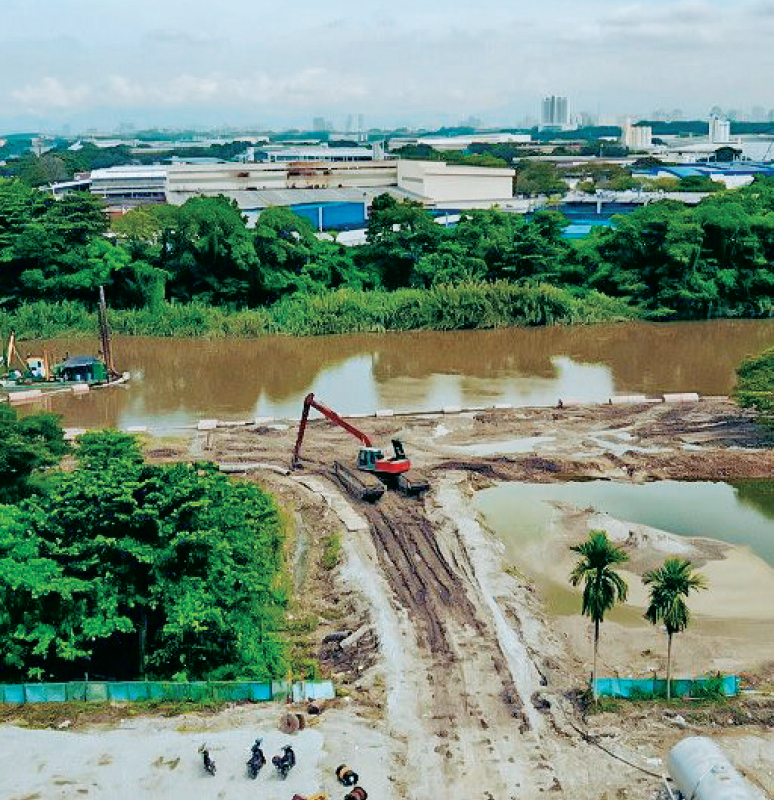
This article first appeared in The Edge Malaysia Weekly on June 19, 2023 - June 25, 2023
Decades of sediment build-up — from chemical spills, sewage and decayed plants — are causing the Klang River to become shallow. During low tide, the depth of the river is as low as 0.5m, when it should be at least 2m or 3m deep.
The flash floods of December 2021, which forced tens of thousands to evacuate, are a reminder of what could happen when rivers overflow during the rainy season. But that’s not the only threat. The Klang River will become a source of raw water for the upcoming Rasau treatment plant, which is necessary to cater to the growing population.
For that to happen, the quality and quantity of water from the river have to be good and consistent, whether during the flood or drought seasons.
That’s why Landasan Lumayan Sdn Bhd, a wholly-owned subsidiary of Menteri Besar Selangor Incorporated, has embarked on a deepening and widening project of the river under the Selangor Maritime Gateway (SMG) project. It is also reinforcing the riverbanks and building bunds, which are structures to control flood water.
“What we are doing in terms of river cleaning, collecting rubbish, river dredging and ensuring water quality will eventually benefit the public. It can ensure the value of their properties and a consistent water supply. Whatever we do will benefit almost two million of the population along the Klang River,” says Syaiful Azmen Nordin, managing director of Landasan Lumayan.
“The Klang River will be the main source of water supply. If there is pollution, we will have to shut down the water treatment plant, which will not only affect the public but also all businesses and factories along the river.”
The project, which has an estimated cost of RM700 million, will be carried out over five years. The Klang River is expected to be deepened by 2m or 3m and its capacity increased by 40%. Twelve zones have been identified as areas that are the most vulnerable to floods and are located 56km downstream of the river.
Stopping waste from entering the river
Deepening the river by dredging it does not eliminate the source of the problem. Reduction of waste flowing into the river is therefore paramount. According to Syaiful, as at February, the company had collected 85,490 metric tonnes of waste in the river.
This was from the first phase of the SMG project, and the collection of waste was done through seven log booms — structures placed at the entry of subsidiary rivers into the Klang River — and the two Interceptor machines that trap floating debris on the river.
The good news is that there has been a reduction of 63% in the waste collected in 2022 compared to 2016, according to Syaiful. In 2016, the total amount of waste collected was 16,408 metric tonsnes, whereas in 2022, the amount was 6,117 metric tonnes.
Activating the community
Community engagement and awareness building are crucial in maintaining the quality of the river as well. Landasan Lumayan is in talks with a non-governmental organisation (NGO) to teach schoolchildren the importance of river care. It is also working with community organisation Alliance of River Three to train the first response emergency team in Taman Sri Muda on preparations in the event of flooding.
Businesses are also expected to play their part. Landasan Lumayan is working with corporations such as Nestlé (Malaysia) Bhd and Westports Malaysia Sdn Bhd to conduct river cleaning exercises. It is also collaborating with Nestlé on a pilot project to recover plastic waste from Kandis River’s log boom.
Additionally, manufacturers along the river have been approached to implement a zero-discharge policy (ZDP) by Lembaga Urus Air Selangor. The ZDP charges companies for the release of effluent into rivers. Instead, companies are encouraged to recycle and reuse water.
One of the areas that Landasan Lumayan has been working on, known as Zone 8, was once an illegal dumping ground, says Syaiful. The waste would flow into the river. He reasons that if the river was the main focus for the community and businesses, it wouldn’t be possible for these sites to become illegal dumping grounds.
“People [see] the river as their backyard and this creates a lot of problems. It is very difficult for enforcement when people use it as their dumping ground,” notes Syaiful.
“We need more people to participate in community development activities along the river. To a certain extent, these [community activities] will contribute to behavioural changes.”
Save by subscribing to us for your print and/or digital copy.
P/S: The Edge is also available on Apple's App Store and Android's Google Play.


